Your browser does not fully support modern features. Please upgrade for a smoother experience.
Please note this is an old version of this entry, which may differ significantly from the current revision.
Subjects:
Agriculture, Dairy & Animal Science
Accurate detection of the onset of parturition is a key factor in the prevention of dystocia in cows. Here we ask experts in the field to share their views and experiences on current best-practice management of the cow before and during calving.
- survey
- veterinarians
- dairy
- calving management
- calving prediction
1. Introduction
Between 2 and 10% of all calves are born dead or die in the next 48 h after birth [1]. To prevent stillbirth and consequences of dystocia and related diseases, experienced personnel is required to detect the onset of parturition [2,3]. Management of periparturient cows is a skill learned through education and experience. However, diverse recommendations are made both in the scientific literature and by veterinary practitioners, for example, for the time of moving cows to maternity pens or time of intervention. In addition, due to the wide variation between cows regarding onset and progression of external signs of parturition [4] even experienced personnel do not detect the onset of all calvings [5]. Though various monitoring devices have been developed for calving detection, visual observation of cow behavior is the most commonly adopted approach [6].
Maternity pens (i.e., separate dedicated areas where calving takes place) not only provide a lower risk of spreading infections [7], but they also minimize the stress level of the cow during parturition [8]. As cows are moved to the maternity pen based on the expected calving date or behavioral or physiological signs, time spent in the maternity pen can vary [9]. According to some authors, an early pen move allows cows to adapt to the new environment, new diet, and in the case of a group calving barn, to the social structure; as these are all stressors that can negatively influence calving performance, especially in heifers [10,11]. In contrast, Gygax et al., 2015 [8] could not find a positive influence of such prepartum exposure to the new environment on calving performance. Moving cows within one or two days pre parturition aligns with cows’ natural isolation-seeking behavior, and on the other hand, will not affect the cleanliness and management of the calving environment too much [12,13]. Other authors found that an early pen move (≥3 d before parturition) is associated with higher incidences of ketosis and displaced abomasum [14]. Moreover, early movement has been associated with dystocia and stillbirth [15], which in turn increases the likelihood of trauma to the cow (i.e., paresis), uterine disease, and decreased milk yield [16,17]. Conversely, if cows are moved too late, during the late first stage of parturition, the second stage may be prolonged [18] which may lead to complications during calving and a 2.5-fold increased risk of stillbirths [19,20]. Therefore, some authors recommend moving cows during stage II of parturition [19,21,22]; “just-in-time” calving.
Specific recommendations regarding the prediction of calving time and consequent movement to the maternity pen are rare. Relaxation of the pelvic ligaments [23] or the concentration of inorganic phosphorus in mammary secretion [24] were recommended for deciding when to move a cow to the maternity pen [24,25]. In practice, clear landmarks such as the amniotic sac or feet of the calf visible outside the vulva are widely used by veterinary practitioners for advice on the just-in-time movement of cows. This apparent gap between what is published by experts in the literature and what veterinary practitioners actually recommend for calving management has not been explored heretofore.
This raises the generic issue of how subject matter experts (SMEs), e.g., academics, might differ from non-SME, e.g., veterinary practitioners, in their recommendations. An adjacent study of causes of perinatal calf mortality revealed a surprising consensus between SME and non-SME [26]. Any potential knowledge discordance between SMEs and non-SMEs is important, as farmers rate veterinarian practitioners as a very important source of information [27,28,29].
2. Response Rates
Of the 104 participants (80 SMEs and 24 non-SMEs) invited to fill in the questionnaire, 54 questionnaires of the online survey and 24 of the workshop survey were returned, with a response rate of 67.5% and 100%, respectively.
Of the 54 respondents in the online survey, 14 (25.9%) viewed the first page with the introduction of the survey; another 17 (31.5%) canceled the questionnaire early in the process, thus 23 SMEs completed all of the questions. While all workshop participants (non-SMEs = 24) finished the questionnaire, nine did not answer every question. In total, 38 out of 104 (36.5%) complete questionnaires were returned (28.8%—23/80 of the online survey; 62.5%—15/24 of the workshop survey). Incomplete questionnaires were included in the analysis; the data were adjusted to the respective number of participants per question.
3. General Information about Participants (Question 1–4)
Most participants were from North America (59.4%—15/40 SMEs; 23/24 non-SMEs), followed by Europe (37.5%—24/40 SMEs; 0/24 non-SMEs) and Asia (23.1%—1/40 SMEs; 1/24 non-SMEs). Overall, almost twice as many men as women participated in the survey (65.6% men—23/40 SMEs; 19/24 non-SMEs; 34.4% women—17/40 SMEs; 5/24 non-SMEs). The average number of scientific peer-reviewed publications ranged from 58.4 publications among SMEs to 2.5 publications among non-SMEs (Question 3, open question). The average number of publications related to calving management was 10.1 by SMEs and 0.4 by non-SMEs (Question 4, open question).
4. Definition of The Stages of Parturition (Question 5–7)
Most participants (89.7%—31/35 SMEs; 21/23 non-SMEs) agreed that the distinction between stage I and II of parturition is helpful in managing calving (Question 5, closed question). A total of 122 descriptors for 12 visible signs to determine stage I of parturition were made by 25 SMEs and 21 non-SMEs (Question 6, open question). Visible signs that were most frequently recommended were “Restlessness” (56.5%—15/25 SMEs; 11/21 non-SMEs), “Tail raising” (50.0%—12/25 SMEs; 11/21 non-SMEs), “Vaginal discharge” (28.3%—7/25 SMEs; 6/21 non-SMEs) and “Relaxation of the pelvic ligaments” (26.1%—9/25 SMEs; 3/21 non-SMEs), (Table 1). SMEs and non-SMEs did not significantly differ in their recommendations for visible signs to determine stage I of parturition.
Table 1. Number of recommendations for visible signs (alphabetized) to determine stage I and stage II of parturition (Question 6 and 7) from subject matter experts in an online survey and non-subject matter experts in a workshop survey.
| Visible Signs of Parturition | Number of Recommendations For | |||
|---|---|---|---|---|
| Stage I of Parturition | Stage II of Parturition | |||
| SMEs 1 (n = 25) |
Non-SMEs 2 (n = 21) |
SMEs (n = 24) |
Non-SMEs (n = 21) |
|
| Abdominal contractions | 5 | 3 | 8 | 8 |
| Behavioral changes | 2 | 1 | - | - |
| Enlargement of the udder | 4 | 1 | - | - |
| Frequent lying/standing transitions | 2 | 0 | - | - |
| Isolation seeking behavior | 4 | 3 | 0 | 1 |
| Lateral recumbancy | - | - | 2 | 4 |
| Milk dripping | 3 | 0 | - | - |
| Reduced feed intake | 2 | 3 | - | - |
| Relaxation of the pelvic ligaments | 9 | 3 | 1 | 0 |
| Restlessness | 15 | 11 | 3 | 0 |
| Rupture of the amniotic sac | 2 | 3 | 2 | 4 |
| Swollen vulva | 0 | 3 | - | - |
| Tail raising | 12 | 11 | 2 | 2 |
| Tripping | 0 | 1 | - | - |
| Uncomfortable walk | - | - | 1 | 0 |
| Vaginal discharge | 7 | 6 | 4 | 2 |
| Vaginal discharge with bloody traces | - | - | 2 | 0 |
| Visibility of foetal parts in vulva | 2 | 1 | 16 | 17 |
| Visible amniotic sac | 0 | 0 | 10 | 6 |
| Vocalization | 0 | 1 | - | - |
1 SMEs = subject matter experts. 2 non-SMEs = non-subject matter experts.
For the description of stage II of parturition (Question 7, open question), 24 SMEs and 21 non-SMEs gave 95 descriptors and listed 12 recommendable signs to observe (Table 1). The most frequently listed signs were “Visibility of fetal parts in the vulva” (73.3%—16/24 SMEs; 17/21 non-SMEs), “Abdominal contractions” (35.6%—8/24 SMEs; 8/21 non-SMEs), or a “Visible amniotic sac” (35.6%—10/24 SMEs; 6/21 non-SMEs). There was no significant difference between SMEs and non-SMEs.
5. Observation Routine (Question 8–10, 16 and 17)
Recommendation by 24 SMEs and 24 non-SMEs on when [days pre expected calving date, (ECD)] to observe cows for signs of parturition and potential movement to the maternity pen ranged from more than 21 days to one day before ECD (Question 8, open question, Figure 3). Respondents recommended close observation at least 7 or 10 days (33.3%—7/24 SMEs; 9/24 non-SMEs) before ECD. SMEs and non-SMEs did not differ significantly in this regard.
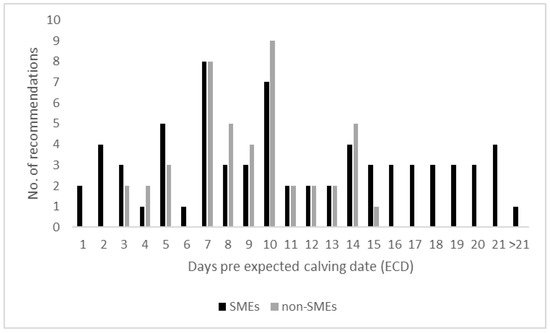
Figure 3. Recommendations for closer observation for signs of parturition of prepartum cows in the dry cow accommodation before movement to the maternity pen (48 respondents—SMEs = 24; non-SMEs = 24).
Recommendations on the daily frequency of observations for signs of impending parturition were dependent on the proximity to parturition (Question 9, semi-open question, Figure 4). This question was answered by 24 SMEs and 24 non-SMEs. For cows that are not yet in the maternity pen, most respondents recommended observation intervals of twice a day (35.4%—8/24 SMEs; 9/24 non-SMEs) and every 6 h (31.3%—6/24 SMEs; 9/24 non-SMEs). Seven participants (14.6%—6/24 SMEs; 1/24 non-SMEs) commented that the observation interval strongly depends on the individual cow and its previous calving performance. The more SIP (signs of imminent parturition) observed the more frequent the number of recommended. As soon as the cow is in the maternity pen (Question 16, semi-open question), the recommended observation intervals were 6 h (45.7%—14/23 SMEs; 7/23 non-SMEs) and 2 h (26.1%—4/23 SMEs; 8/23 non-SMEs). Two participants (4.3%—2/23 SMEs; 0/23 non-SMEs) chose none of the options and stated that the observation interval depends on the individually observable signs of parturition. Answers of SMEs and non-SMEs did not differ significantly.
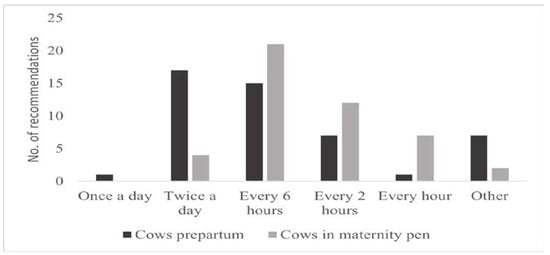
Figure 4. Recommendations on frequency of observations per day for prepartum cows before movement to the maternity pen (48 respondents—SMEs = 24; non-SMEs = 24) and for cows that are in the maternity pen (46 respondents—SMEs = 23; non-SMEs = 23).
A majority of study participants recommended moving cows to a maternity pen (81.3%—20/24 SMEs; 19/24 non-SMEs); the other 9 participants (18.8%—4/24 SMEs; 5/24 non-SMEs) disagreed with this practice (Question 10, closed question). The recommendations of SMEs and non-SMEs did not differ significantly.
6. Signs of Parturition (Question 11, 12, 14, and 15)
Twenty-two SMEs and 21 non-SMEs named 21 important signs of parturition (Figure 5). “Abdominal contractions” (44.2%—19/22 SMEs; 9/21 non-SMEs) “Vaginal discharge” (32.6%—4/22 SMEs; 10/21 non-SMEs) and the “Visibility of fetal parts” (30.2%—8/22 SMEs; 5/21 non-SMEs) were listed most frequently. “Enlargement of the udder” has been listed less frequently, but significantly more frequent by non-SMEs (p = 0.04).
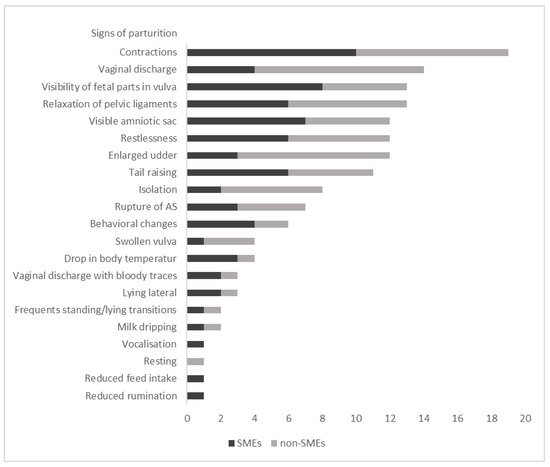
Figure 5. Important signs of parturition (n = 21) listed by SMEs (n = 22) in an online survey and non-SMEs (n = 21) in a workshop survey.
In question 11 we offered a choice of ten signs of parturition to determine the right time to move a cow to the maternity pen. The most common responses were “Relaxation of the pelvic ligaments”, (50.0%—14/24 SMEs; 8/20 non-SMEs) and “Behavioral changes” (34.1%—8/24 SMEs; 7/20 non-SMEs) (Figure 6). Thirteen participants, but significantly more non-SMEs (10/20) than SMEs (3/24) (p = 0.009) stated “Gestation length” was a recommendable parameter. Some of those recommended 3 weeks (n = 5) or 1 week (n = 3), others 2 weeks (n = 1) or three days (n = 1) before ECD. All 39 respondents estimated the predictive value of their recommended SIPs in the upper range (i.e., 41–60%, 61–80% and 81–100%), but only 10.3% of respondents (2/24 SMEs; 2/15 non-SMEs) considered the predictive value of their selection to be very certain (i.e., 81–100%). Most respondents (59.0%—13/24 SMEs; 10/15 non-SMEs) estimated the predictive value of their recommendation at 61–80%. There was no significant difference between SMEs and non-SMEs.
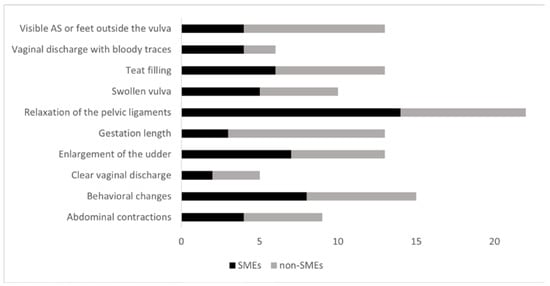
Figure 6. Number of recommendations (alphabetized) for visible signs of parturition to determine the right time for moving a cow to the maternity pen (44 respondents—SMEs = 24; non-SMEs = 20).
On a 5-point Likert scale, respondents fully agreed that “Lying lateral with abdominal contractions” (83.0%—18/23 SMEs; 21/24 non-SMEs), “Tail raising” (51.1%—16/23 SMEs; 8/24 non-SMEs; p = 0.02), and “Vaginal discharge with bloody traces” (48.9%—11/23 SMEs; 12/24 non-SMEs) were very important to check on a regular basis as signs of parturition. “Tripping” was found to be very important by SMEs only (8.5%—4/23 SMEs; 0/24 non-SMEs; p = 0.05) (Question 15, closed question, Figure 7).
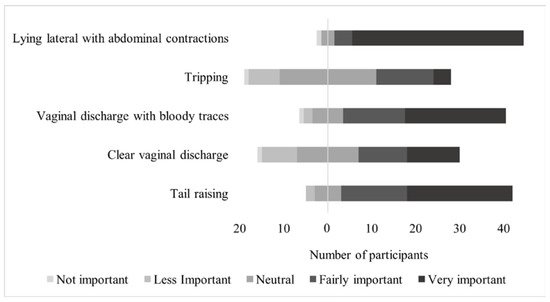
Figure 7. Agreement (5-point Likert scale) with the importance of 5 signs of parturition (47 respondents—SMEs = 23; non-SMEs = 24).
This entry is adapted from the peer-reviewed paper 10.3390/ani11113129
This entry is offline, you can click here to edit this entry!
